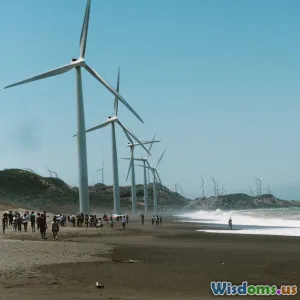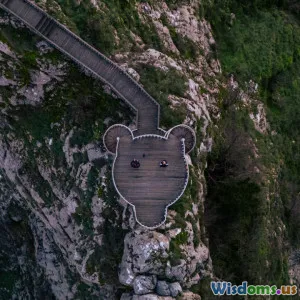
The Impact of Tourism on the Environment: A Deep Dive
7 min read Explore the profound environmental effects of tourism and discover sustainable solutions for a greener future. (0 Reviews)
The Impact of Tourism on the Environment: A Deep Dive
Tourism, often seen as a pathway to cultural exchange and economic growth, carries a complex and sometimes troubling relationship with the environment. While millions eager to explore new destinations reap immense personal satisfaction, the natural world often bears a heavy toll. This article delves into the environmental consequences of tourism and presents actionable insights toward achieving a sustainable balance.
Understanding Tourism's Environmental Footprint
The travel sector contributed approximately 8% of global greenhouse gas emissions in 2019, with tourism-related transport accounting for around 5% of global emissions alone (UNWTO, 2021). These figures underscore the significant role tourism plays in global climate change, primarily driven by air travel and vehicle use.
Moreover, tourism intensifies resource consumption in fragile ecosystems, accelerating degradation of natural habitats. For example, the Great Barrier Reef in Australia suffers from increased water pollution and coastal development linked to tourist infrastructure, compounding threats like coral bleaching.
Key Environmental Impacts
1. Carbon Emissions and Climate Change
Aviation is the fastest-growing source of carbon emissions worldwide. Tourism-related flights, especially long-haul voyages, produce large volumes of CO₂, warming the planet and threatening biodiversity. According to the International Air Transport Association (IATA), before the pandemic, global air passenger traffic grew by 4.2% annually, showing rising emissions correlate with increased tourism.
2. Habitat Destruction and Loss of Biodiversity
Tourism development often leads to land clearing, deforestation, and disruption of wildlife habitats. For example, expanding resort areas in the Amazon rainforest facilitates deforestation, undermining one of the world’s richest biodiversity hotspots.
At popular destinations like Machu Picchu, the surge of tourists necessitated trail closures to prevent erosion and damage to archaeological sites and surrounding ecology. This showcases the delicate balance between conservation and visitation.
3. Water Usage and Pollution
Tourists typically consume two to three times more water than local residents. In water-scarce regions, this demand can lead to shortages affecting local communities. The island of Bali, for instance, faces stark water challenges due to its tourism industry’s consumption.
Additionally, untreated sewage and litter from resorts and cruise ships pollute rivers, coral reefs, and marine life habitats, causing long-lasting damage.
4. Waste Generation and Management Challenges
The influx of tourists produces immense amounts of solid waste, often overwhelming local infrastructure. Venice experiences this first-hand, where an estimated 30 million visitors per year produce waste volumes exceeding the city's capacity, threatening its waterways and historic architecture.
5. Cultural Impact and Local Community Strain
While primarily environmental, tourism's footprint extends to societal elements, indirectly contributing to resource exploitation and environmental strain due to increased population density and altered consumption patterns.
Innovative Responses and Sustainable Tourism Models
1. Ecotourism and Conservation Efforts
Ecotourism represents an approach prioritizing environmental preservation, education, and local community benefits. Costa Rica leads as a model, where protected areas receive funding from thoughtful tourism, enhancing biodiversity and local economies simultaneously.
2. Technology and Carbon Offsetting
Travel companies and airlines increasingly promote carbon offset programs. For example, JetBlue offers passengers carbon-neutral flights by investing in renewable energy and forest preservation projects.
3. Regulating Tourist Numbers and Infrastructure
Several destinations have enacted caps on daily visitor numbers to reduce environmental stress. Bhutan requires all tourists to pay a daily sustainable development fee, minimizing overtourism and funding conservation.
Similarly, the Galápagos Islands enforce stringent visitor limits coupled with eco-friendly regulations to protect endemic species.
4. Promoting Sustainable Practices Among Travelers
Educating tourists is critical. Initiatives like the Leave No Trace program guide travelers on minimizing their environmental impact—emphasizing waste management, respecting wildlife, and supporting local communities.
5. Alternative Transport and Greener Accommodations
Shifting from air to rail travel where possible, utilizing electric vehicles, and supporting hotels with sustainability certifications (e.g., LEED, Green Key) can significantly reduce tourism's ecological footprint.
How Travelers Can Make a Difference
- Choose eco-friendly destinations and lodgings: Look for certified green hotels and locally managed eco-tourism operations.
- Adopt low-impact transportation: Favor trains or buses over planes when feasible.
- Respect local ecosystems: Avoid disruptive activities, pack out all trash, and adhere to guidelines.
- Support local economies: Buy local products and engage in cultural exchanges that benefit communities.
- Offset your carbon footprint: Use credible offset programs to balance emissions.
Conclusion
Tourism’s impact on the environment is undeniable—it propels economies but also threatens the very landscapes and cultures it celebrates. The challenge lies in evolving travel models toward sustainability. Through collective responsibility involving governments, businesses, and travelers, it is possible to safeguard nature’s wonders for future generations. Empowered with knowledge and conscious choices, everyone can contribute to a greener, more sustainable travel future.
By understanding tourism’s environmental costs and embracing sustainable practices, we not only protect our planet but enrich our travel experiences with purpose and respect for the natural world.
Rate the Post
User Reviews
Popular Posts





















